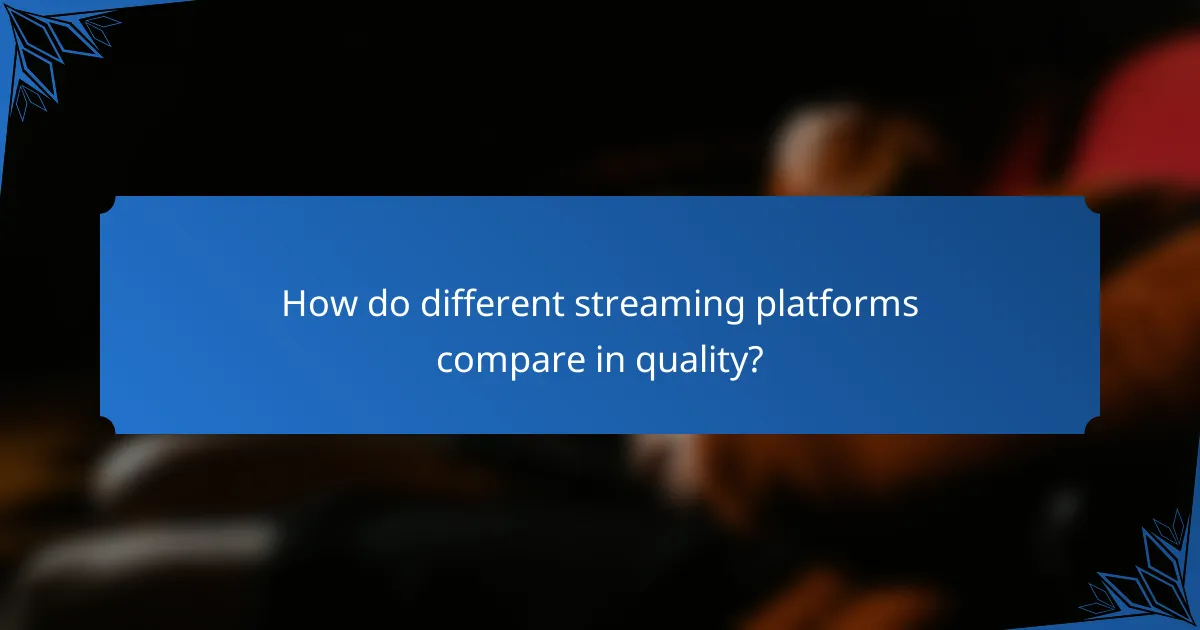Streaming quality plays a crucial role in determining data usage, user experience, and overall costs for consumers. Higher resolutions can enhance clarity and enjoyment but also lead to increased data consumption, potentially resulting in higher charges from internet service providers and subscription fees. As such, users must carefully consider their streaming quality choices in relation to their internet plans and budget.

How does streaming quality affect data usage in the US?
Streaming quality significantly impacts data usage in the US, with higher resolutions consuming more data. Users should consider their internet plans and data caps when choosing streaming quality to avoid unexpected charges.
High-definition streaming uses more data
High-definition (HD) streaming typically uses around 3 to 7 gigabytes (GB) of data per hour. This increased data consumption is due to the higher resolution, which provides a clearer and more detailed picture. For users with limited data plans, streaming in HD can quickly eat into their monthly allowance.
For instance, a movie streamed in HD could consume a significant portion of a standard 100 GB monthly plan, leaving less room for other online activities. Users should weigh the benefits of enhanced visual quality against their data limits.
Standard-definition streaming uses less data
Standard-definition (SD) streaming generally uses about 1 to 2 GB of data per hour, making it a more data-friendly option. While the picture quality is lower than HD, many users find it sufficient for casual viewing, especially on smaller screens.
Choosing SD can be a practical solution for those with strict data caps or slower internet connections. It allows for longer viewing times without the risk of exceeding data limits.
Data caps impact streaming choices
Many internet service providers in the US impose data caps, which can limit streaming options. Users with lower data caps may need to prioritize SD over HD to avoid overage fees. Understanding your plan’s limits is crucial for making informed streaming decisions.
To manage data usage effectively, consider monitoring your streaming habits and adjusting quality settings based on your remaining data. Some streaming services offer options to reduce data consumption, which can help maintain a balance between quality and usage.

What is the impact of streaming quality on user experience?
Streaming quality significantly affects user experience by influencing clarity, detail, and overall enjoyment of content. Higher quality typically leads to greater satisfaction, while lower quality can result in frustration and disengagement.
Higher quality improves viewing satisfaction
Higher streaming quality enhances viewing satisfaction by providing clearer images and more vibrant colors. Users generally prefer resolutions like 1080p or 4K, which offer a more immersive experience compared to standard definition. The difference can be particularly noticeable on larger screens, where lower resolutions may appear pixelated.
To achieve optimal quality, ensure a stable internet connection with sufficient bandwidth, typically at least 25 Mbps for 4K streaming. This helps maintain a seamless viewing experience without interruptions.
Buffering affects user engagement negatively
Buffering can severely disrupt user engagement, leading to frustration and potential abandonment of content. Even a few seconds of buffering can cause viewers to lose interest, especially if they are in the middle of an exciting scene. Studies suggest that users are likely to stop watching if buffering occurs frequently.
To minimize buffering, consider using a wired connection instead of Wi-Fi, or upgrading your internet plan if necessary. Streaming services often provide recommendations for optimal settings based on your connection speed.
Audio quality influences overall experience
Audio quality plays a crucial role in the overall streaming experience, as clear sound enhances storytelling and immersion. Poor audio can detract from the enjoyment of music, dialogue, and sound effects, making it harder for viewers to connect with the content.
For the best audio experience, consider using headphones or a quality sound system, and ensure that your streaming service supports high-definition audio formats. This can significantly elevate the enjoyment of movies and shows, making them more engaging.

How does streaming quality affect costs for consumers?
Streaming quality significantly impacts costs for consumers by influencing data usage and subscription fees. Higher quality streams consume more data, which can lead to increased charges from internet service providers and higher monthly subscription costs for premium services.
Higher data usage can lead to increased bills
Streaming in high definition (HD) or ultra-high definition (UHD) requires substantially more data compared to standard definition (SD). For instance, HD streaming can use around 3 GB per hour, while UHD might consume up to 7 GB per hour. Consumers on limited data plans may face overage charges if they exceed their data limits.
To manage costs, consider monitoring your data usage and adjusting streaming quality settings based on your plan. Reducing the quality from UHD to HD can save significant data and help avoid unexpected bills.
Subscription plans vary by streaming quality
Many streaming services offer tiered subscription plans based on streaming quality. For example, a basic plan might provide SD quality at a lower cost, while HD and UHD plans come at a premium. This means consumers need to evaluate their viewing habits and decide if the higher quality justifies the additional expense.
When choosing a plan, consider how often you watch content in high quality. If you frequently stream movies or shows on large screens, investing in a higher-tier plan may enhance your viewing experience.
Free streaming options may compromise quality
Free streaming services often provide lower quality content as a trade-off for no subscription fees. These platforms may limit resolution to SD or include ads, which can detract from the viewing experience. While they can be a cost-effective option, the quality may not meet the expectations of viewers accustomed to premium services.
For those prioritizing quality, it may be worth investing in a subscription service. However, if budget constraints are a concern, carefully selecting free options and being aware of their limitations can still provide entertainment without added costs.

What are the prerequisites for optimal streaming quality?
To achieve optimal streaming quality, a high-speed internet connection and compatible devices are crucial. These factors significantly influence the clarity, speed, and overall experience of streaming content.
High-speed internet connection is essential
A high-speed internet connection is vital for smooth streaming. Generally, a minimum download speed of 25 Mbps is recommended for HD content, while 4K streaming may require speeds of 50 Mbps or more. Slower connections can lead to buffering and reduced video quality.
Consider your household’s internet usage as well. If multiple devices are streaming or using bandwidth simultaneously, you may need to increase your internet plan to maintain quality. Checking your current speed using online speed tests can help you assess if your connection meets these requirements.
Compatible devices enhance streaming performance
Using compatible devices can significantly improve your streaming experience. Devices such as smart TVs, streaming boxes, and gaming consoles are designed to handle high-quality video playback efficiently. Ensure that your device supports the streaming service’s required resolution and formats.
Additionally, keeping your device’s software updated can help optimize performance and compatibility with the latest streaming technologies. If you’re using older devices, consider upgrading to models that support current streaming standards, such as 4K or HDR, for the best experience.

How do different streaming platforms compare in quality?
Different streaming platforms offer varying quality levels that can significantly impact user experience and data usage. Factors such as resolution, bitrate, and adaptive streaming capabilities play crucial roles in determining the overall quality of the content delivered.
Netflix offers multiple streaming quality options
Netflix provides several streaming quality options, including Standard Definition (SD), High Definition (HD), and Ultra High Definition (UHD). Users can select their preferred quality based on their internet speed and data plan, with UHD requiring a stable connection of around 25 Mbps.
To manage data usage, Netflix allows users to adjust playback settings. For instance, streaming in SD consumes about 1 GB per hour, while HD can use up to 3 GB per hour. This flexibility helps users stay within their data limits while enjoying their favorite shows.
Amazon Prime Video provides adaptive streaming
Amazon Prime Video employs adaptive streaming technology, which automatically adjusts video quality based on the user’s internet connection. This ensures a smoother viewing experience, minimizing buffering and interruptions.
Users can expect resolutions ranging from SD to UHD, with data consumption varying accordingly. For example, streaming in UHD may use around 7 GB per hour, making it essential for users to monitor their data usage, especially on limited plans.
Hulu’s quality varies by subscription tier
Hulu offers different streaming quality based on the subscription tier. The basic plan provides SD quality, while the ad-free and Live TV plans offer HD streaming. Users should consider their subscription level when assessing the quality of content available.
Data usage on Hulu can also vary; streaming in HD typically consumes about 3 GB per hour. Users on limited data plans should be mindful of their settings and consider downloading content for offline viewing when possible to save on data costs.

What emerging trends are shaping streaming quality?
Emerging trends in streaming quality include advancements in technology and changing consumer preferences, which significantly impact user experience and data consumption. Key developments like 5G, AI optimization, and the demand for higher resolution content are driving improvements in how streaming services deliver video.
5G technology enhances mobile streaming quality
5G technology is revolutionizing mobile streaming by providing faster data speeds and lower latency. This allows users to stream high-definition content without buffering, even in crowded areas. As 5G networks expand, mobile users can expect a more reliable and seamless streaming experience.
With 5G, data transfer rates can reach up to 10 Gbps, which is substantially higher than 4G. This means that streaming services can deliver higher quality video, such as 4K and even 8K content, without compromising performance. Users should consider upgrading their devices to take full advantage of these capabilities.
AI-driven optimization improves data usage
AI-driven optimization techniques are enhancing streaming quality by intelligently managing data usage. These technologies analyze user behavior and network conditions to adjust video quality in real-time, ensuring a smooth viewing experience while minimizing data consumption.
For instance, AI can automatically lower the resolution during peak usage times or when the network is congested, which helps prevent buffering. Users should look for streaming services that utilize AI to optimize their viewing experience, especially if they have data caps on their internet plans.
Consumer demand for 4K content is rising
Consumer demand for 4K content is increasing as more households acquire 4K-capable devices. This trend is pushing streaming platforms to offer more high-resolution options, enhancing the overall viewing experience with sharper images and better color accuracy.
Streaming services are investing in original content produced in 4K, which requires higher bandwidth for optimal playback. Users should ensure they have sufficient internet speed, typically at least 25 Mbps, to stream 4K content smoothly. Additionally, they may want to consider subscription plans that offer 4K streaming options to fully enjoy this trend.



